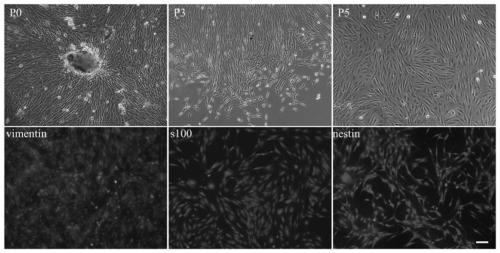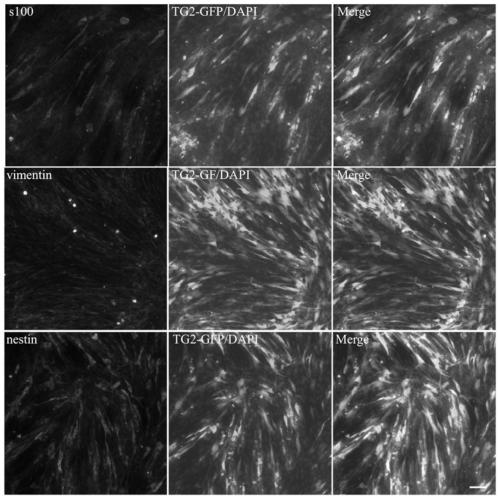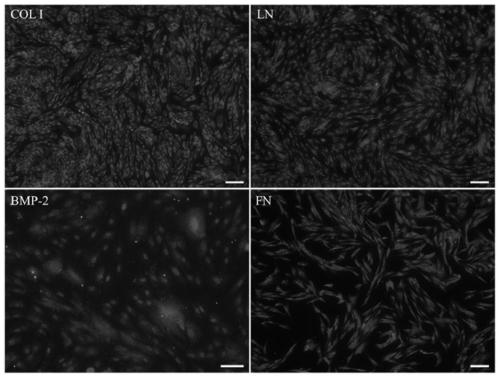Composite biology bracket material for repairing bone defects
A bio-scaffold and bone defect technology, applied in the field of bone tissue engineering, can solve the problems of side effects of degradation products, production cost, poor biocompatibility, and time for seed cell damage, degradation and absorption, etc.
- Summary
- Abstract
- Description
- Claims
- Application Information
AI Technical Summary
Problems solved by technology
Method used
Image
Examples
Embodiment 1
[0054] The cultivation and identification of embodiment 1 EMSCs
[0055] Deeply anesthetize SD rats (50-100g, male or female) with 10% chloral hydrate, cut the skin along the nasal cavity up to the inner canthus under sterile conditions, expose the lower nasal septum and inferior turbinate mucosa, take out the nasal septum and place it in PBS buffer solution, the full-thickness nasal mucosa was peeled off. After the nasal mucosa was taken out, it was rinsed three times with FBS medium at 4°C and shredded sufficiently, placed in a 37°C incubator and digested with trypsin for 15 minutes, centrifuged at 1000r / min to discard the supernatant, and inoculated the crushed tissue pieces in a medium containing sufficient 10% A closed culture flask of FBS DMEM / F12 was placed in a cell culture incubator. After most of the tissue pieces adhere to the wall, the medium is aspirated and new medium is added. The medium was changed every 3 days, and the cells were subcultured when the cells c...
Embodiment 2
[0057] Example 2 TG2 Gene Recombinant Adenovirus Transfection EMSCs and Determination of TG2 Expression Level
[0058] The following primers were designed to synthesize the TG2 (NCBI: NP_803473.1) gene: TG2-f, CTAGCTAGCGCCACCATGGCCGAGGAGCTGAACCT and TG2-r, GGAATTCTTAGGCCGGGCCGATGATGA. The recombinant rat TG2 (rTG2) adenovirus shuttle plasmid was constructed by Nanjing Genscript Bioengineering Technology Service Co., Ltd. (Nanjing, China) and confirmed by sequencing.
[0059] The TG2 gene was inserted into the pShuttle-IRES-hrGFP2 vector to prepare the shuttle vector pShuttle-IRES-hrGFP2-TG2, and the pShuttle-IRES-hrGFP2 vector was set as a control group. 293A cells (2×10 6 cells / well) seeded in 6 cm of DMEM medium supplemented with 10% FBS 2 Petri dish and at 37 °C, 5% CO 2 Incubate overnight. Change the medium before transfection. Cells were transfected with pacAd5-9.2-100 and pShuttle-IRES-hrGFP2-TG2 shuttle plasmids at 80-90% confluence using Lipofectamine 2000. After...
Embodiment 3
[0063] Example 3 Preparation of Fibrin Scaffold and Cell Seeding
[0064] The fibrin scaffold was made by mixing Solution A and Solution B and solidifying. Solution A was a 100 mg / mL rat fibrinogen solution dissolved in PBS, and Solution B contained 100 U rat thrombin dissolved in 5 mL PBS. Prepare fibrin scaffolds by mixing solution A and solution B in a 1:1 volume ratio so that the final concentration of fibrinogen is 50 mg / mL. Immediately and evenly drop the mixed fibrinogen-thrombin mixture onto a 96-well, 48-well or 6-well cell culture plate, and then incubate the cell culture plate at 37° C. for 30 minutes. The above-mentioned cultured TG2-EMSCs and EMSCs were digested with trypsin, centrifuged and pelleted, and the cells were collected as seed cells. Then the seeded cells are seeded on the fibrin support in the above-mentioned culture plate, and cultured by adding appropriate common complete medium. Cell-scaffolds were fixed with 4% paraformaldehyde in phosphate buff...
PUM
| Property | Measurement | Unit |
|---|---|---|
| Diameter | aaaaa | aaaaa |
Abstract
Description
Claims
Application Information
 Login to View More
Login to View More - R&D
- Intellectual Property
- Life Sciences
- Materials
- Tech Scout
- Unparalleled Data Quality
- Higher Quality Content
- 60% Fewer Hallucinations
Browse by: Latest US Patents, China's latest patents, Technical Efficacy Thesaurus, Application Domain, Technology Topic, Popular Technical Reports.
© 2025 PatSnap. All rights reserved.Legal|Privacy policy|Modern Slavery Act Transparency Statement|Sitemap|About US| Contact US: help@patsnap.com



